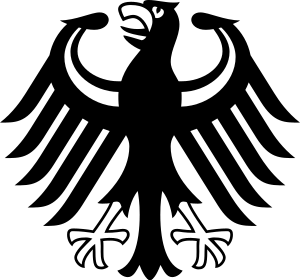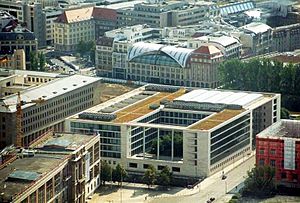Foreign Office of Germany facts for kids
| Auswärtiges Amt | |
 |
|
| Agency overview | |
|---|---|
| Formed | 1870, Reichsauswärtigesamt |
| Jurisdiction | Government of Germany |
| Headquarters | Berlin |
| Minister responsible |
|
| Website | http://www.auswaertiges-amt.de |
The Foreign Office or AA (German: Auswärtiges Amt) is the main government department in Germany that handles the country's relationships with other nations. It is in charge of Germany's foreign policy and its role in the EU. The Foreign Office is led by the Federal Minister for Foreign Affairs (German: Bundesminister des Auswärtigen).
Contents
What the Foreign Office Does
The Foreign Office is a key part of Germany's foreign service. It helps Germany connect with other countries and big international groups like the United Nations. For example, it worked to get Germany a permanent spot on the UN Security Council in 2005.
The main office is in Berlin, close to where the old DDR Foreign Ministry used to be. The Foreign Office also has a second important office in Bonn.
Since January 2017, Sigmar Gabriel from the SPD has been the Foreign Minister.
How the Foreign Office is Organized
Germany has many embassies, consulates, and consulates-general around the world. These are like Germany's offices in other countries. You can find them in most capital cities and larger towns.
The main office in Berlin helps to plan Germany's diplomacy. It also studies all the information sent back from the embassies and consulates. These offices are like the "eyes, ears, and voice" of the German government in other countries.
The Foreign Office has many locations abroad:
- 145 embassies
- 59 consulates general
- 12 permanent offices at international organizations
- 10 other offices
There are also three "German Information Centres (GIC)". Their job is to share information about Germany and the German language. The biggest GIC is in Washington, DC, USA. Another one is in Cairo, Egypt, for Arabic-speaking countries. The third GIC is in Paris, France, for French-speaking areas.
Germany also has 356 honorary consuls. These are often German business people who help the Foreign Office in their spare time.
The Bonn Office
The office in Bonn mainly handles information technology. Every German office abroad is connected to Bonn. This allows information to be sent quickly to Berlin. The Bonn office also helps the Foreign Minister and the Chancellor communicate when they are traveling abroad.
Challenges Faced
Sometimes, people have raised concerns about how senior jobs are chosen at the Foreign Office.
In the past, the Foreign Office used to publish the details of its top diplomats. But they stopped doing this after some attacks. For example, terrorists attacked the German embassy in Stockholm in 1975. Also, a diplomat named Gerold von Braunmühl was murdered in 1986 by the RAF. To keep their diplomats safer, the Foreign Office decided not to share this information anymore.
A Look at History
Early Beginnings
The Foreign Office started in 1870. It was part of the North German Confederation. Back then, it was led by a permanent secretary, not a minister. This is why it was called an "Office" and not a "ministry" for a long time.
German Empire (1871-1918)
When the German Empire was formed in 1871, it took over the Foreign Office. It was located in Berlin. Even though there was an empire, the different German states still had some control over their own foreign policy.
The Foreign Office had different teams, or "departments," to handle various tasks. For example, one team dealt with important political matters and staff. Another team handled trade, travel, and helping Germans living abroad. Over time, new teams were added, like one for legal matters and another for colonies.
Weimar Republic (1919-1933)
After World War I, Germany became the Weimar Republic. The Foreign Office then became a full "ministry," led by a Reich Minister. This minister was now fully in charge of foreign policy. The name "Foreign Office" was kept because of tradition. Gustav Stresemann was a very famous foreign minister during this time. He shaped Germany's foreign policy a lot, just like Bismarck had done earlier.
The Third Reich (1933-1945)
When the Nazis came to power, the Foreign Office started to follow their ideas. However, some people inside the Foreign Office tried to resist, like Adam von Trott zu Solz and Ulrich von Hassell.
After World War II, Germany was under Allied control until 1955. This meant there was no need for a German Foreign Office until 1951, when the new Germany began to manage its own affairs again.
Federal Republic of Germany
The new Foreign Office for West Germany was set up on March 15, 1951, in Bonn. It kept the traditional name "Office."
Many senior officials in the new Foreign Office had been members of the Nazi Party. In fact, a higher percentage of former Nazi Party members held top jobs in the Foreign Office after the war than during the Third Reich.
Since 1966, the Foreign Minister has often been the leader of the smaller party in a coalition government.
German Democratic Republic (East Germany)
East Germany also had its own Ministry for Foreign Affairs. It handled the foreign policy for the East German government until Germany was reunified in 1990.
Recent Foreign Ministers
Here are some of the people who have served as Foreign Minister for the Federal Republic of Germany since 1951:
- Konrad Adenauer (1951-1955) - He was also the Chancellor at the same time.
- Willy Brandt (1966-1969)
- Walter Scheel (1969-1974)
- Hans-Dietrich Genscher (1974-1982 and 1982-1992) - He served under both a Social Democratic and a Christian Democratic Chancellor.
- Joschka Fischer (1998-2005)
- Frank-Walter Steinmeier (2005-2009 and 2013-2017)
- Guido Westerwelle (2009-2013)
- Sigmar Gabriel (2017-Present)
Related pages
- German Academic Exchange Service (DAAD), an organization mainly funded by the Foreign Office.


